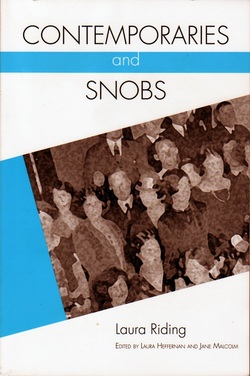
Contemporaries and Snobs was first published by Doubleday Doran in 1928, during the period (1925-30) of Riding’s most influential presence in the international high modernist writing scene. It was a time in which she published poetry and commentary in major modernist journals, was in contact with Gertrude Stein, Wyndham Lewis and T.S. Eliot, lived with Robert Graves and co-wrote with Graves A Survey of Modernist Poetry (1927), which the editors of this volume describe as the “first formal study to consider the work of E.E. Cummings, Hart Crane, Conrad Aitken, Marianne Moore, Ezra Pound, Vachel Lindsay, T.S. Eliot, John Crow Ransom, Edith Sitwell, and Allen Tate as a single movement” (xi).
There is no surprise in its being republished: it’s an important document not only of the male dominance of that literary scene but also of the conflicts within it that are often understated in literary histories. There is perhaps some mystery in it being republished within Alabama’s “Modern/Contemporary” Poetics series edited by Charles Bernstein and Hank Lazer. Is there a connection being implied between the literary politics of the 1920s and those of recent US poetry? Are Riding’s acid criticisms of Eliot’s self-canonizing essays and her perceptive readings of Stein being reframed in order also to reframe the various works of Language poets?
However what could impress a reader first in Riding’s book is how distant her assumptions are from those in contemporary poetry. While challenging Eliot’s emphasis on ridding poetry of the personal and subjective, his stress on impersonality, she also readily accepts his implication that literature and literary periods can be only classical or romantic, and uses it to construct a history of English literature and Western culture as an oscillation of classical and
 RSS Feed
RSS Feed